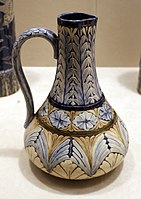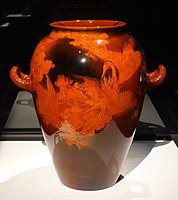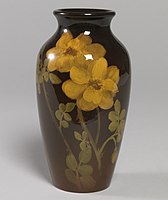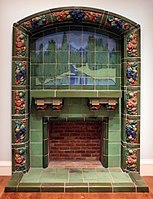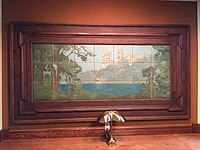
Delftware or Delft pottery, also known as Delft Blue or as delf, is a general term now used for Dutch tin-glazed earthenware, a form of faience. Most of it is blue and white pottery, and the city of Delft in the Netherlands was the major centre of production, but the term covers wares with other colours, and made elsewhere. It is also used for similar pottery, English delftware.

Frederick Hurten Rhead (1880–1942) was a ceramicist and a major figure in the Arts and Crafts movement. A native of England, he worked as a potter in the United States for most of his career. In addition to teaching pottery techniques, Rhead was highly influential in both studio and commercial pottery. He worked for the Roseville Pottery, established his own Rhead Pottery (1913–1917), and in 1935 designed the highly successful Fiesta ware for Homer Laughlin China Company.
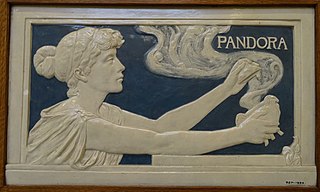
The Della Robbia Pottery was a ceramic factory founded in 1894 in Birkenhead, near Liverpool, England. It closed in 1906. Initially it mostly made large pieces with high artistic aspirations, especially relief panels for architectural use, but also ornamental vessels and plates, intended for display rather than use.

Van Briggle Art Pottery was at the time of its demise the oldest continuously operating art pottery in the United States, having been established in Colorado Springs, Colorado in 1901 by Artus and Anne Van Briggle. Artus had a significant impact on the Art Nouveau movement in the United States, and his pottery is foundational to American Art Pottery. The Art Nouveau style favored by its founders continues to influence the pottery's designs.

The Roseville Pottery Company was an American art pottery manufacturer in the 19th and 20th centuries. Along with Rookwood Pottery and Weller Pottery, it was one of the three major art potteries located in Ohio around the turn of the 20th century. Though the company originally made simple household pieces, the Arts and Crafts–inspired designs proved popular, and Roseville pieces are now sought after by collectors.
The Overbeck sisters were American women potters and artists of the Arts and Crafts Movement who established Overbeck Pottery in their Cambridge City, Indiana, home in 1911 with the goal of producing original, high-quality, hand-wrought ceramics as their primary source of income. The sisters are best known for their fanciful figurines, their skill in matte glazes, and their stylized designs of plants and animals in the Art Nouveau and Art Deco styles. The women owned and handled all aspects of their artistic enterprise until 1955, when the last of the sisters died and the pottery closed. As a result of their efforts, the Overbecks managed to become economically independent and earned a modest living from the sales of their art.

Maria Longworth Nichols Storer was the founder of Rookwood Pottery of Cincinnati, Ohio, United States, a patron of fine art and the granddaughter of the wealthy Cincinnati businessman Nicholas Longworth.
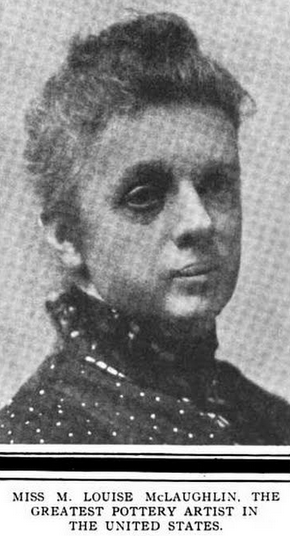
Mary Louise McLaughlin was an American ceramic painter and studio potter from Cincinnati, Ohio, and the main local competitor of Maria Longworth Nichols Storer, who founded Rookwood Pottery. Like Storer, McLaughlin was one of the originators of the art pottery movement that swept the United States.

Kataro Shirayamadani, also known as Kitaro Shirayamadani was a Japanese ceramics painter who worked for Rookwood Pottery in Cincinnati, Ohio from 1887 until 1948.

Pilkington's Lancastrian Pottery & Tiles was a manufacturer of tiles, vases and bowls, based in Clifton near Pendlebury, Lancashire, England. The company was established in 1892 at Clifton Junction, alongside Fletcher's Canal. The company employed talented designers, the most famous of whom was Charles Voysey. Production of art pottery was stopped at the end of the 1930s, although tile production continued. Today the site is occupied by Pilkington's Group Plc.

Ephraim Faience Pottery is an American art pottery company founded in 1996 in Deerfield, Wisconsin, United States by Kevin Hicks and two partners who have since left the company. It is now located in Lake Mills, Wisconsin. The company produces art pottery in the tradition of the Arts and Crafts Movement with matte glazes over sculpted earthenware in editions of no more than 500 pieces. It produces primarily vases, as well as bowls, lidded boxes, candleholders, pitchers and lanterns. In the past, it has also produced tiles and sculpted paperweights. A prototypical Ephraim Faience piece is a vase finished in a matte green background color, and embellished with sculpted decorative representations of plant or animal life. The company also produces pieces in other colors and in non-representational designs. In 2009, the company employed eight artisans.

Art pottery is a term for pottery with artistic aspirations, made in relatively small quantities, mostly between about 1870 and 1930. Typically, sets of the usual tableware items are excluded from the term; instead the objects produced are mostly decorative vessels such as vases, jugs, bowls and the like which are sold singly. The term originated in the later 19th century, and is usually used only for pottery produced from that period onwards. It tends to be used for ceramics produced in factory conditions, but in relatively small quantities, using skilled workers, with at the least close supervision by a designer or some sort of artistic director. Studio pottery is a step up, supposed to be produced in even smaller quantities, with the hands-on participation of an artist-potter, who often performs all or most of the production stages. But the use of both terms can be elastic. Ceramic art is often a much wider term, covering all pottery that comes within the scope of art history, but "ceramic artist" is often used for hands-on artist potters in studio pottery.

The Grueby Faience Company, founded in 1894, was an American ceramics company that produced distinctive American art pottery vases and tiles during America's Arts and Crafts Movement.
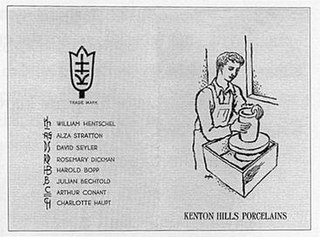
Kenton Hills Porcelains were high-fired soft paste porcelain products manufactured by Kenton Hills Porcelains, Inc. Ceramics were produced from 1940 to 1943 in Erlanger, Kentucky, with sales continuing to 1944. All ceramic products were made from native clays. Products include vases, bookends, figurines, lamp bases, and flowerpots.
Samuel Augustus Weller, one of the pioneer pottery manufacturers of Ohio in the United States, founded the S.A. Weller Pottery in Fultonham, Ohio, in 1872. In 1882 he moved the business to Zanesville, Ohio, and for more than a half-century Weller Pottery produced both utilitarian pieces and more decorative art pottery lines.

China painting, or porcelain painting, is the decoration of glazed porcelain objects such as plates, bowls, vases or statues. The body of the object may be hard-paste porcelain, developed in China in the 7th or 8th century, or soft-paste porcelain, developed in 18th-century Europe. The broader term ceramic painting includes painted decoration on lead-glazed earthenware such as creamware or tin-glazed pottery such as maiolica or faience.

Albert Robert Valentien (1862–1925) was an American painter, botanical artist, and ceramic artist. He is best known for his work as the chief ceramics decorator at Rookwood Pottery, and for his watercolor paintings of botanical subjects. In 1908, he accepted a commission from philanthropist Ellen Browning Scripps to illustrate the botanical diversity of California. Over the next ten years, he produced approximately 1200 watercolor "plant portraits" of native California wildflowers, grasses, ferns, and trees.

American art pottery refers to aesthetically distinctive hand-made ceramics in earthenware and stoneware from the period 1870-1950s. Ranging from tall vases to tiles, the work features original designs, simplified shapes, and experimental glazes and painting techniques. Stylistically, most of this work is affiliated with the modernizing Arts and Crafts (1880-1910), Art Nouveau (1890–1910), or Art Deco (1920s) movements, and also European art pottery.

The J. B. Owens Pottery Company, informally known as Owens Pottery, was an American art pottery and tile company that flourished for a few years around the turn of the 20th century.
Wheatley Pottery Company produced ornamental vases, lamps, and ceramic tile in Cincinnati, Ohio. Their autumn leaf tiles were used on the Franklin Building, along Printer's Row in Chicago. The MET has an earthenware umbrella stand from the company in its collection.





